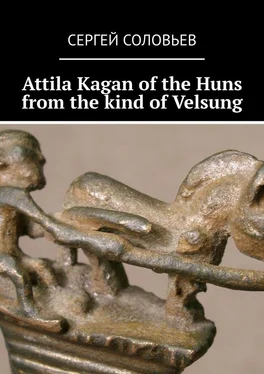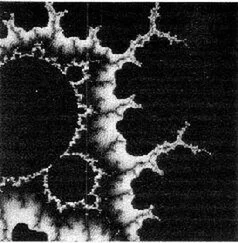Сергей Соловьев - Attila Kagan of the Huns from the kind of Velsung
Здесь есть возможность читать онлайн «Сергей Соловьев - Attila Kagan of the Huns from the kind of Velsung» — ознакомительный отрывок электронной книги совершенно бесплатно, а после прочтения отрывка купить полную версию. В некоторых случаях можно слушать аудио, скачать через торрент в формате fb2 и присутствует краткое содержание. ISBN: , Жанр: Прочая документальная литература, История, Детская образовательная литература, на английском языке. Описание произведения, (предисловие) а так же отзывы посетителей доступны на портале библиотеки ЛибКат.
- Название:Attila Kagan of the Huns from the kind of Velsung
- Автор:
- Жанр:
- Год:неизвестен
- ISBN:9785449804464
- Рейтинг книги:5 / 5. Голосов: 1
-
Избранное:Добавить в избранное
- Отзывы:
-
Ваша оценка:
- 100
- 1
- 2
- 3
- 4
- 5
Attila Kagan of the Huns from the kind of Velsung: краткое содержание, описание и аннотация
Предлагаем к чтению аннотацию, описание, краткое содержание или предисловие (зависит от того, что написал сам автор книги «Attila Kagan of the Huns from the kind of Velsung»). Если вы не нашли необходимую информацию о книге — напишите в комментариях, мы постараемся отыскать её.
Attila Kagan of the Huns from the kind of Velsung — читать онлайн ознакомительный отрывок
Ниже представлен текст книги, разбитый по страницам. Система сохранения места последней прочитанной страницы, позволяет с удобством читать онлайн бесплатно книгу «Attila Kagan of the Huns from the kind of Velsung», без необходимости каждый раз заново искать на чём Вы остановились. Поставьте закладку, и сможете в любой момент перейти на страницу, на которой закончили чтение.
Интервал:
Закладка:
As said, this creature lives in the earth. It digs passages and tunnels with its horn and thereby opens the keys, cleans the springs and fills the lakes and rivers with water. And if the indrik-beast rises under the ground, “the whole Universe will shake.” True, this is not a predatory beast, but a completely peaceful giant: “it does not offend anyone”, apparently eats plants or whatever it finds underground. Well, it is quite possible that in this case we are talking about real mammoths, whose tusks and frozen carcasses are often found in Siberia. Apparently, the legendary mole-giant tin-shu, and fan-shu, and indrik-beast, and the Finnish mamut are one and the same creature. The modern Russian name “mammoth” just comes from the old Russian word “mamut”. The Russians borrowed it from the Finnish tribes inhabiting European Russia. In many Finnish dialects, “ma” means “earth,” and “mut” means Finnish “mole,” meaning Mamut is an earth mole.
“The mountain gave birth to a mouse” is a saying in ancient Greece and Rome. What does it mean? Apollon —Sminfei, Sminfey (Σμινθεύς), in Greek myth-making, the epithet of the god Apollo in the north-west of Asia Minor in Troas. The very name Cminfey is derived from the word αμίνθος, which meant a Cretan mouse. In this regard, the mouse was an attribute of the prophetic god Apollo, hence the name of it ζωον μαντικώτερον (prophetic animal). One of the months (Σμίνθειον) was named by the name of Sminfey; in addition, ancient Greek authors mention the Rhodes festival of Sminfey. Pisarevsky writes that “The mouse in the cult of Apollo with Asclepius corresponds to the mole in the cult of Rudra with Ganesha” [Pisarevsky c / 5] (The legend that the elephant fears only the mouse).And if you examine further, then Ganesha and Indrik are also identical, the message about one Ganesh horn is interesting.. So, one tusk from Ganesha is Indrik (probably Apollon-Sminfey) and what is this tusk horn? Look at the curved swords of the Hittites daggers, Danish swords from Rorbi, the Sejm culture. And the image of the Hittite deities is shown with a curved sword, and the Danish sword is generally not a weapon, it is a ritual object, and most of all resembles an elephant’s tusk.
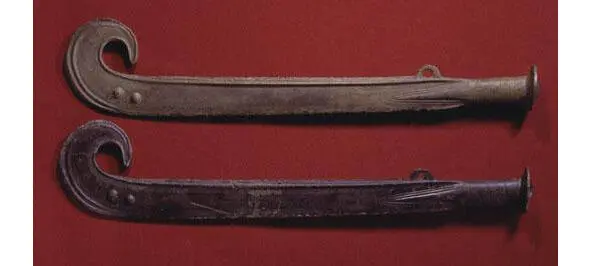
Swords from Rorbi, Denmark.
While irrigating a plot of land in Rorby, western Zealand in 1952, Torvald Nielsen discovered a curved bronze sword covered in ancient images. The sword was dated to the beginning of the Bronze Age, (around 1600 BC), and was at that time the first such sword found in Denmark. Thorvald Jensen, five years later, in the same place, while working in the garden, accidentally dug another curved sword. The found sword, like the first one, was covered with a pattern, and there was an image of an ancient ship with two pins. This is the oldest ship image in Scandinavia. These are also the most ancient metal swords found in modern Scandinavia. But these artifacts cannot be called weapons; they have never been imprisoned. The Hittites, a people in Asia Minor, had the same type of sword. Judging by the images on the bas-reliefs, similar swords were worn for ritual purposes by both the Hittite rulers and deities, according to the book of O. Henry “The Hittites” p. 201.
Among the monuments of the Sejm-Turbino culture, among the exhibits of the State Historical Museum of Moscow, there is a curved dagger, which, obviously, was used for ritual purposes.
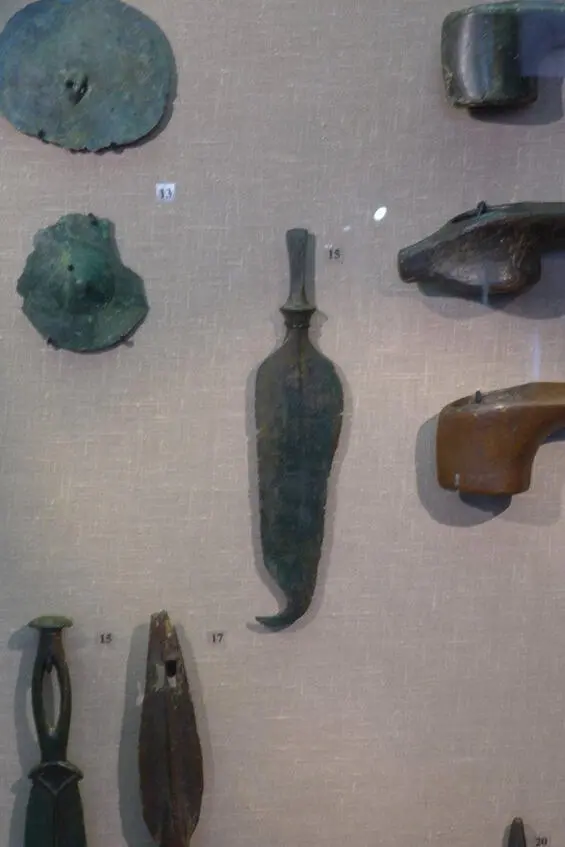
Seima-Turbino culture. GIM, Moscow.
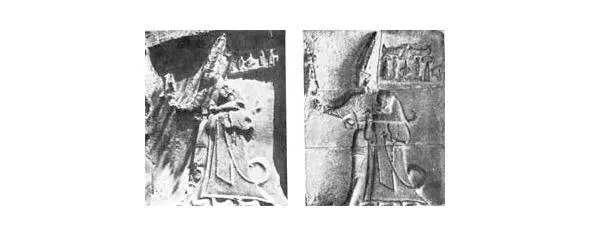
Twisted dagger, Relief depicting a Hittite deity. Turkey.
Of considerable interest is the sanctuary of the Kaninsky cave in the Trinity-Pechersky district of the Komi Republic. A feature of this place is the presence of traces of the activity of two cultural horizons: Seima-Turbino and medieval. In addition, single tools of the early Iron Age were found in the cave. In the cave, 41 damaged objects made of metal of the Seima-Turbino type were found. That is, the sanctuary has been used continuously for thousands of years.
Probably all of these ritual curved swords and daggers served as an attribute of worship of the gods, and not for military purposes. And the similarity between them is obvious, it is likely that these objects copied in some sense the Horn of Ganesha (Indrika), because the deity had only one horn, according to myths. And in Russian, the origin of the weapon from the Horn (the word Horn) remained, and in Latin from the word hand-armor (that is, the Romans thought the weapon was a continuation of the hand). It turns out that the horn of Indrik (Ganesha) was presented as a sacred object, a sacred weapon (probably, as in the sense of the Sungir burial, a weapon from a mammoth tusk was considered magic), and this probably explains the use of ivory for the hilt of weapons in later times. That is, the migration of Indo-Aryans from the coast of the Arctic Ocean is proved by the toponymy of places, the location of mammoth burial grounds in that region, and the emergence of myths about Ganesha, Apollon and Indrik-Zvere, in the areas of the Ob river basin, and the present Arkhangelsk, Vologda regions and the Komi Republic, and Khanty-Mansiysk Okrug, where even now there are cases of finds of the remains of mammoths. Also, numerous finds of the most valuable artifacts in the Yamal region and the mouth of the Ob river, as well as in the region of the river. Later Kama, the so-called “Zakamsky silver”, which was most likely the offerings from Iran, Byzantium to the sanctuaries of the Far North, described by Herodotus, who considers these places to be connected with the veneration of Apollo, and Herodotus gives evidence of Aristean who visited the High North in fulfillment vows. That is, the tradition, the recollections of the ancestral home, already at a later time turned out to be so strong that offerings to the gods to the ancestral home of the Indo-Europeans were sent from Iran and Greece, to which there is material evidence, these are the treasures of Yamal and Zakamsky treasures.
GANTS INDIA AND GANESHA
Ganesha, or Ganapati (Sansk. Gaṇeśa)) in Hinduism, the god of wisdom and prosperity. This is one of the most famous and revered gods of the Hindu pantheon. Often before his name is added the respectful prefix Sri-. One popular way of worshiping Ganesha is by chanting the Ganesha-sahasranama, the “thousand names of Ganesha”), each of which symbolizes a separate aspect of God, and the Ganapati-sukta un Shiva and Parvati. At the same time, the Puranic myths contradict each other, describing the birth of Ganesha. In some cases, it is said that Ganesha was created by Shiva, in others – it was created by Parvati, in the third – jointly by Shiva and Parvati. Variants are known in which Ganesha appeared to the world in an incomprehensible way and was discovered by Shiva and Parvati, who adopted him.
Brother Ganesha – Skanda (Kartikeya, Murugan). In the northern part of India, it is generally accepted that the eldest of the brothers is Skanda. In the southern part, the birth championship is attributed to Ganesha. Skanda was revered as an important warlike deity from the 5th century BC. e. according to the VI century AD e. Mass worship of Ganesha began after the sunset of the cult of Skanda. The opinions of myths also differ regarding the marital status of Ganesha. Some myths attribute Ganesha to the brahmacharyas who could not marry. This opinion is widespread in the south of India and, in part, in its northern part. According to another version, Ganesha is associated with such ideas as Buddhi (intellect, mind), Siddhi (success) and Riddhi (prosperity). Sometimes these ideas (concepts) were personified in the deities of the same name, which were recognized by the wives of Ganesha. Another option claims that the wife of Ganesha was the goddess of culture and arts of Saraswati, or the goddess of luck and prosperity Lakshmi. A version circulated in Bengal connects Ganesha with the banana tree of Cala Bo. According to one legend, the father of Ganesha was deprived of his father by the god Shiva. Ganesha did not let his father, inflamed with a passion for his wife, into the chambers where she was. Then Shiva angrily stripped his head, throwing it so far that no one sent could find her. The goddess was angry and refused to admit Shiva to him until he corrected the situation. To reassure his wife, Shiva sewed the head of a nearby elephant to Ganesha. According to another version, on the birthday of Ganesha they forgot to invite the god Shani (personification of the planet Saturn), and he, appearing without an invitation, incinerated the baby’s head with anger. Then the Brahmaposov advised Shiva to sew on the baby the head of the very first being that he met. This creature turned out to be the elephant of Indra – Ayravat. According to oral Indian myths, Saturn (Shani), being one of the relatives, was invited to honor the newborn son of Shiva: the mother of Ganesha, Parvati certainly wanted to show the powerful relative a beautiful baby. With a deadly look that he was unable to control, Shani refused the invitation for a long time, but he was still persuaded. First Shani’s look at the son of Shiva incinerated his head. According to another version, the head just fell off. Regarding the loss of one tusk, there are also several versions of legends. According to one of the legends of Ganesha, fighting the giant Hajamukkha himself broke his tusk and threw it at the enemy. The tusk possessed magical power, and Gajamukha turned into a rat, then becoming the animal of Ganesha. Another legend says that one day Shiva was visited by the sage Parasurama (avatar of Vishnu), but Shiva was sleeping at that time, and Ganesha refused to let him in. Then Parasurama threw his ax into Ganesha and cut off his right tusk. There is also a legend that, recording Mahabharata under the dictation of Vyasa, Ganesha broke his pen and, not wanting to miss a word, broke a tusk and began to write to them.
Читать дальшеИнтервал:
Закладка:
Похожие книги на «Attila Kagan of the Huns from the kind of Velsung»
Представляем Вашему вниманию похожие книги на «Attila Kagan of the Huns from the kind of Velsung» списком для выбора. Мы отобрали схожую по названию и смыслу литературу в надежде предоставить читателям больше вариантов отыскать новые, интересные, ещё непрочитанные произведения.
Обсуждение, отзывы о книге «Attila Kagan of the Huns from the kind of Velsung» и просто собственные мнения читателей. Оставьте ваши комментарии, напишите, что Вы думаете о произведении, его смысле или главных героях. Укажите что конкретно понравилось, а что нет, и почему Вы так считаете.
